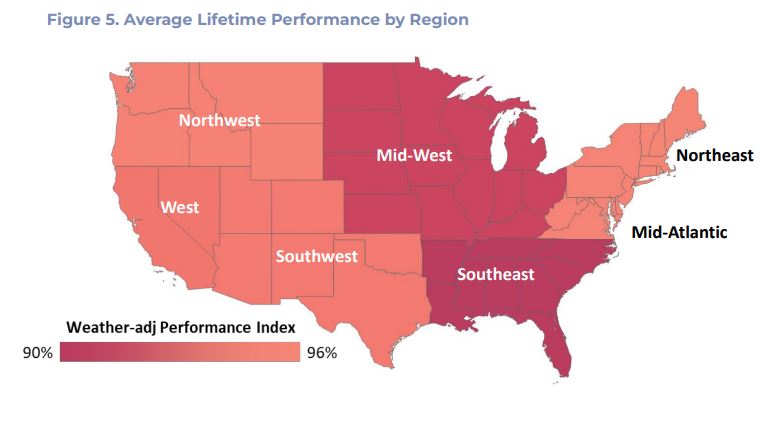From pv magazine USA
kWh Analytics, a climate insurance firm, says in its 2022 Solar Generation Index that solar assets are broadly performing below expectations. The report incorporates data from industry collaborators and kWh Analytics’ proprietary Heliostat database.
On average, projects constructed after 2015 have generated 7% to 13% less electricity than P50 production estimates. P50 means there is a 50% chance in any given year that production will be at least a specific amount. If an array has a P50 production level of 500 kWh, it means that on any given year there is a 50% chance that production will be at least 500 kWh.
The report concluded that as the gap between actual and expected generation grows, underperformance risk jeopardizes investor returns and the industry’s ability to achieve sustainable growth.
“Underperformance affects investors and lenders critical to the success and growth of solar projects,” said Jason Kaminksy, chief executive officer of kWh Analytics. “As an industry, we must collaborate to find ways to course-correct in order to ensure the industry’s long-term financial health.”
The average performance of projects constructed last year represented a minor improvement compared to 2020. In general, projects built since 2015 are performing worse than those constructed in the early 2010s relative to their P50 estimates.
The kWh Analytics report showed that since 2019, projects with capacities greater than 50 MW have performed worse relative to their P50 estimates than projects in the range of 1 MW to 50 MW.
The underperformance trend is a nationwide phenomenon, said kWh Analytics. Under 10 years of operational data, average lifetime performance ranged from 5% to 10% below initial P50 estimates across the seven regions. Over the years, performance continues to decline in each region. The only outliers in 2021 were the Northwest and Southeast regions, which improved by 1% and 2%, respectively.
“It is imperative that we continue to support the long-term success of the renewable energy sector,” said Kaminksy. “To de-risk investments into zero-carbon assets and encourage resilience throughout the industry, sponsors and lenders should consider accurately priced risk-transfer products, be wary of aggressive production forecasts, and be collaborative with stakeholders to encourage data sharing.”
The report also evaluated system performance based on project capacities and mount types. It did not find any underperformance trends isolated to any specific groups of projects.
This content is protected by copyright and may not be reused. If you want to cooperate with us and would like to reuse some of our content, please contact: editors@pv-magazine.com.




2 comments
By submitting this form you agree to pv magazine using your data for the purposes of publishing your comment.
Your personal data will only be disclosed or otherwise transmitted to third parties for the purposes of spam filtering or if this is necessary for technical maintenance of the website. Any other transfer to third parties will not take place unless this is justified on the basis of applicable data protection regulations or if pv magazine is legally obliged to do so.
You may revoke this consent at any time with effect for the future, in which case your personal data will be deleted immediately. Otherwise, your data will be deleted if pv magazine has processed your request or the purpose of data storage is fulfilled.
Further information on data privacy can be found in our Data Protection Policy.